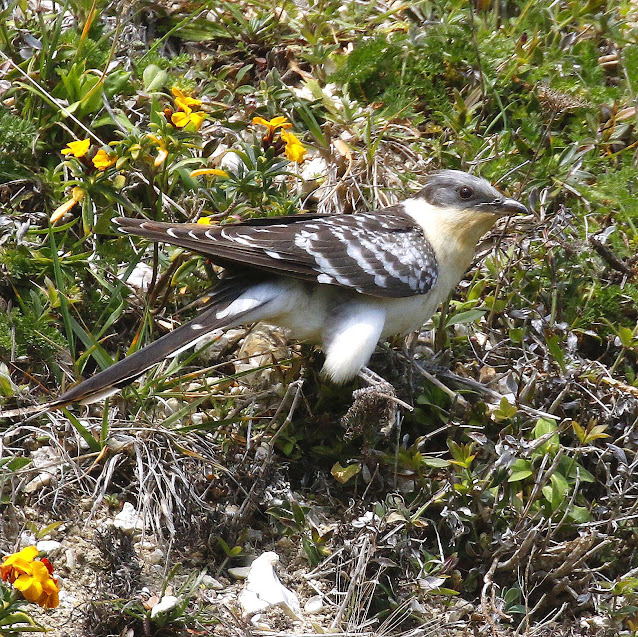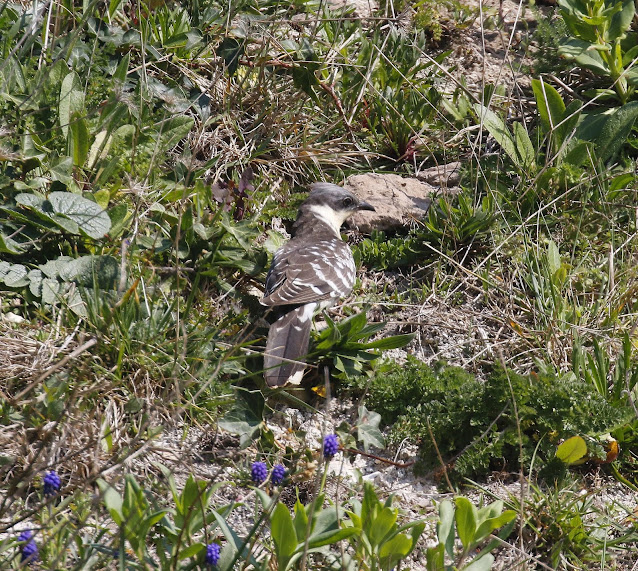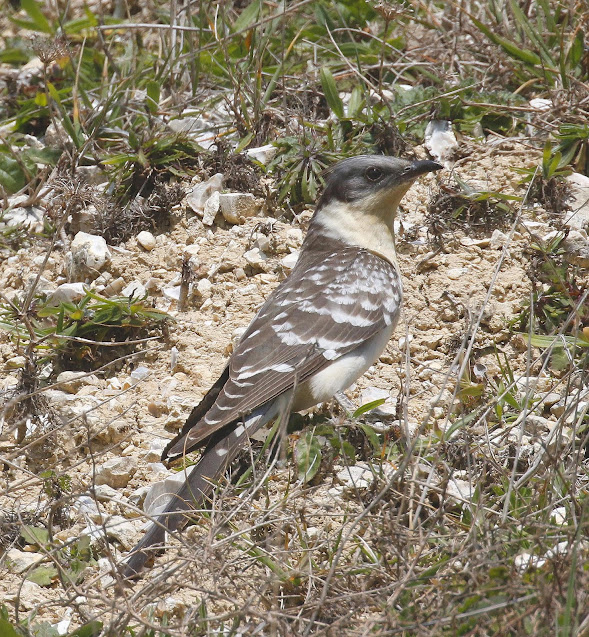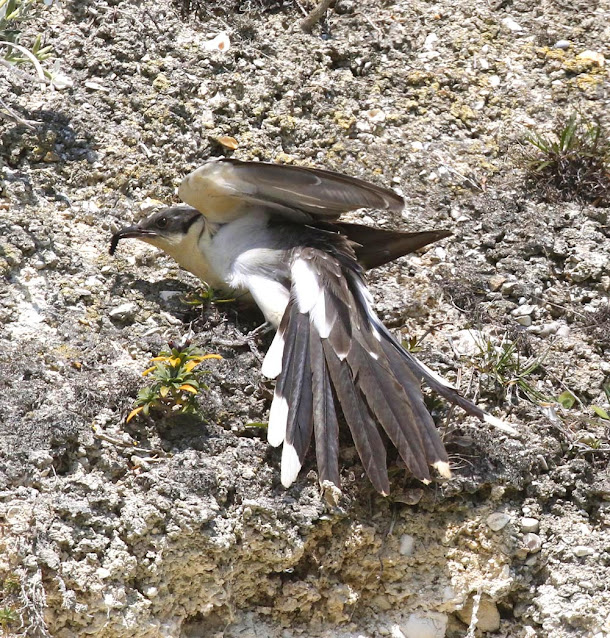On Thursday the 21st March a Great Spotted Cuckoo was discovered at Wheeler's Bay which lies to the east side of the town of Ventnor on the Isle of Wight but having already seen three of this very rare visitor in Britain and also breeding in Botswana, I was not too fussed and decided to leave it.
One or two Great Spotted Cuckoos arrive in Britain almost annually, appearing as an overshooting early spring migrant. Their normal range is from southern France southwards around the Mediterranean basin, then throughout southern Africa to as far as South Africa. In the European parts of their range they are migrants, spending the winter south of the Sahara where other populations are resident, and it is these birds returning from their winter quarters that are probably the ones that occasionally stray too far north and end up on Britain's southern shores.
To date there have been fifty one occurrences of Great Spotted Cuckoos in Britain and eight in Ireland. They are usually found in the southern coastal counties of Britain and this one, currently on the south coast of the Isle of Wight was a typical record.
On Saturday Mark contacted me to ask if I was going to go and see the cuckoo on Monday but I had other plans involving a visit to Hayling Island in Hampshire and then going on to the RSPB's Lodmoor Reserve in Dorset. On Tuesday evening Mark rang again and said that after seeing some nice images of the cuckoo on social media, he and Adrian were minded to go for the cuckoo on Wednesday and would I like to come too.
To cut a long story short I met them at 7am on Wednesday morning at the Wightlink Ferry Terminal in Portsmouth but not having booked Mark's car on the ferry the first sailing we could get was not until an hour later. However a cup of coffee and a forty minute crossing on the eight o'clock ferry, found us driving off at Fishbourne and crossing the island to the pleasant little Victorian town of Ventnor which lies on the southern side of the island, possessing, if you believe the locals, its own Mediterranean micro climate. Our anxiety levels, or I should say Mark's, returned to normal as news came through that the Great Spotted Cuckoo had been seen this very morning in its usual place on the cliff at Ventnor.
The directions to the cuckoo on RBA (Rare Bird Alert) told us to park at Wheeler's Bay and walk a quarter of a mile east to 'the revetments' an upmarket word for sea defences and look for the cuckoo on the sloping grassy cliff side rising up from the promenade below, which formed part of 'the revetments'. The weather could not have been better with sun and a slight but chilly wind. We descended a large number of steps from the car park and proceeded to walk east along an almost deserted promenade.We met a local birder on the way who showed us the general area the cuckoo frequented which was anywhere for a quarter of a mile along the cliff.
A Northern Wheatear flew in off the sea and settled briefly on the cliff side before disappearing over the top.
When the cuckoo first arrived at Ventnor it had found a fairly extensive area of brambles growing on the lower part of the cliff and was eating large numbers of Brown tailed Moth larvae that were in their distinctive web like nests woven in the brambles. When these ran out it had moved slightly more to the west and was now eating the larvae of Glanville Fritillarys which posed something of a dilemna for the local conservationists as this particular cliffside is the only location in Britain where this ultra rare butterfly breeds. Obviously there was nothing that could be done and it had to be hoped the cuckoo would eventually return south.The thought did occur to me that it might well remain until the caterpillars ran out!
At first there was no sign of the cuckoo and we stood staring at the steeply sloping chalk cliff covered in short grass, dead stems and various downland plants with scars of bare white chalk here and there. At the top of the cliff were one or two isolated conifers and some bushes. It should not be too hard to see the cuckoo on the cliff side if it was here.
Twenty minutes passed and other local birders joined us. A lady came along the promenade and told us she had just been at the top of the cliff and seen the cuckoo at the top being harassed by two Magpies and it had flown down onto the cliff slope a hundred metres to the west of us. We walked back to where she thought it had flown and at that moment a dog walker pointed to a tree and said 'It's in there'. We hurried to the spot and sure enough there was the cuckoo.
To cut a long story short I met them at 7am on Wednesday morning at the Wightlink Ferry Terminal in Portsmouth but not having booked Mark's car on the ferry the first sailing we could get was not until an hour later. However a cup of coffee and a forty minute crossing on the eight o'clock ferry, found us driving off at Fishbourne and crossing the island to the pleasant little Victorian town of Ventnor which lies on the southern side of the island, possessing, if you believe the locals, its own Mediterranean micro climate. Our anxiety levels, or I should say Mark's, returned to normal as news came through that the Great Spotted Cuckoo had been seen this very morning in its usual place on the cliff at Ventnor.
The directions to the cuckoo on RBA (Rare Bird Alert) told us to park at Wheeler's Bay and walk a quarter of a mile east to 'the revetments' an upmarket word for sea defences and look for the cuckoo on the sloping grassy cliff side rising up from the promenade below, which formed part of 'the revetments'. The weather could not have been better with sun and a slight but chilly wind. We descended a large number of steps from the car park and proceeded to walk east along an almost deserted promenade.We met a local birder on the way who showed us the general area the cuckoo frequented which was anywhere for a quarter of a mile along the cliff.
 |
| Looking west to Ventnor from along the promenade |
 |
| Looking east by and along the cliff the cuckoo was frequenting and also home to the Glanville Fritillary |
When the cuckoo first arrived at Ventnor it had found a fairly extensive area of brambles growing on the lower part of the cliff and was eating large numbers of Brown tailed Moth larvae that were in their distinctive web like nests woven in the brambles. When these ran out it had moved slightly more to the west and was now eating the larvae of Glanville Fritillarys which posed something of a dilemna for the local conservationists as this particular cliffside is the only location in Britain where this ultra rare butterfly breeds. Obviously there was nothing that could be done and it had to be hoped the cuckoo would eventually return south.The thought did occur to me that it might well remain until the caterpillars ran out!
 |
| The Great Spotted Cuckoo's temporary home. Initially it hid from the crows in the distant conifers |
 |
| Birders looking for the cuckoo.This constitutes a twitch on The Isle of Wight |
Its pale body made it obvious where it was perched in the tree although it was partially obscured by twigs and foliage but at least the first priority to see it had now been achieved.
The cuckoo was wise to be circumspect about showing itself as three Carrion Crows had taken exception to its presence and were harrying it at every opportunity, causing the cuckoo for its part to maintain a low profile in the cover of trees. Eventually it flew down onto the upper slope and commenced hunting for caterpillars in the short grass, again giving little opportunity to get a nice picture of it. As soon as the crows saw it they chased it back into a tree.
The cuckoo, like virtually all its tribe is parasitic, using other birds to raise its young by laying a single egg at a time in the nests of Magpies and Carrion Crows, so it is understandable why it was creating such a stir with the local corvids but it was still frustrating for us, as while the crows were around the cuckoo was unwilling to leave the sanctuary of the trees.
Eventually the crows departed and the cuckoo felt emboldened to fly down onto the cliffside once more and commence searching the grass for caterpillars. In flight it appeared slim and attenuated due to its very long tail, demonstrating a delightful fast, bounding, dipping flight similar to a Magpie. Its incredibly long tail and broad wings were particularly noticeable.
When feeding on the ground it walked and hopped awkwardly with almost reckless abandon amongst the grass, stopping frequently for extended periods to look about, moving its head from side to side, waiting for any movement that would betray the presence of a caterpillar.
When it saw something to eat it would bound over to it, sometimes overbalancing in its haste to seize the prey, using spread wings and tail to counteract its clumsiness.
There were occasional periods when it flew up and over the top of the cliff and out of sight but we soon learned that its main food source was here on the cliff face and it always eventually returned. Adrian spent much energy chasing after it on the cliff top but Mark and myself remained on the promenade looking up the cliff and this proved the best option.
By now quite a gathering had congregated at the bottom and the excited chatter and disturbance undoubtedly persuaded the cuckoo to remain on the higher part of the cliff but after a couple of hours most people had dispersed and Mark and myself found ourselves on our own and then the cuckoo in a series of short flights descended much lower.
My initial impressions were of a bird similar to a magpie in size and proportions especially with the long tail but it was slimmer in build. This individual was an adult and had a dark grey face and a paler grey, punk like crest which it could raise and lower at will, a substantial bill and a creamy buff chin and throat.The rest of the underparts were white. Its name comes from the liberal white spotting on its grey brown upperparts, especially the wings. The similarly coloured tail was very long and the graduated tail feathers were extensively tipped with white apart from the central pair.
We watched it for some time trying to get an image that did not include bits of annoying vegetation.It was not easy as the cuckoo continually cased the slope looking for food, often delving deep into the leaves and dead stems. It found a hotspot for Glanville Fritillary larvae and in the space of twenty minutes I watched it consume no less than thirty four of the unfortunate black larvae, snatching them from the leaves and tossing them in the air to swallow whole. Eventually, stuffed full, it sank onto a small grass tussock and sat there, replete and content, in the sun. It must have been very pleasant up there on the sun warmed chalky cliff and maybe reminded it of its proper home in southern Europe.
This particular cliff side as I said is the location for our rarest native fritillary butterfly and various conservation measures have been taking place to make the habitat as beneficial as possible. Alas it is obviously impossible to legislate for or anticipate an occurrence such as this with the cuckoo and one just has to hope that the cuckoo's predation of the fritillary larvae will not have a significant long term impact.
Lunchtime arrived and we left Adrian still trying to get an image of the cuckoo he was happy with while we walked back along the promenade to a seafront cafe to sit in the sun and enjoy a coffee and a sandwich And very pleasant it was too.
Refreshed we rejoined Adrian, taking a sandwich and a drink for him and then we returned to the cliff and took yet more images of the cuckoo. The numbers of people began to build up again, both birders and curious passers by, even a group of excited school children on an outing joined us. Noise levels inevitably increased and the cuckoo just as inevitably maintained its distance high up on the cliff.
Tired of craning my neck I decided to go and look for Wall Lizards, a non native lizard species but common in Europe, which were introduced to Ventnor in the late 1860's and now thrive there. I found three separate individuals basking on the sun warmed concrete steps of a currently closed cafe. This was a first for me and I was especially pleased to see them.
Rejoining the others and a now ever increasing gathering of curious people we came to the conclusion we were not going to get any better images or views than we had already achieved and so made our way back to the car.
What a lovely day it had turned out to be, in a beautiful location by the seaside and in great company.
 |
| First views of the Great Spotted Cuckoo |
The cuckoo, like virtually all its tribe is parasitic, using other birds to raise its young by laying a single egg at a time in the nests of Magpies and Carrion Crows, so it is understandable why it was creating such a stir with the local corvids but it was still frustrating for us, as while the crows were around the cuckoo was unwilling to leave the sanctuary of the trees.
Eventually the crows departed and the cuckoo felt emboldened to fly down onto the cliffside once more and commence searching the grass for caterpillars. In flight it appeared slim and attenuated due to its very long tail, demonstrating a delightful fast, bounding, dipping flight similar to a Magpie. Its incredibly long tail and broad wings were particularly noticeable.
When feeding on the ground it walked and hopped awkwardly with almost reckless abandon amongst the grass, stopping frequently for extended periods to look about, moving its head from side to side, waiting for any movement that would betray the presence of a caterpillar.
When it saw something to eat it would bound over to it, sometimes overbalancing in its haste to seize the prey, using spread wings and tail to counteract its clumsiness.
There were occasional periods when it flew up and over the top of the cliff and out of sight but we soon learned that its main food source was here on the cliff face and it always eventually returned. Adrian spent much energy chasing after it on the cliff top but Mark and myself remained on the promenade looking up the cliff and this proved the best option.
By now quite a gathering had congregated at the bottom and the excited chatter and disturbance undoubtedly persuaded the cuckoo to remain on the higher part of the cliff but after a couple of hours most people had dispersed and Mark and myself found ourselves on our own and then the cuckoo in a series of short flights descended much lower.
My initial impressions were of a bird similar to a magpie in size and proportions especially with the long tail but it was slimmer in build. This individual was an adult and had a dark grey face and a paler grey, punk like crest which it could raise and lower at will, a substantial bill and a creamy buff chin and throat.The rest of the underparts were white. Its name comes from the liberal white spotting on its grey brown upperparts, especially the wings. The similarly coloured tail was very long and the graduated tail feathers were extensively tipped with white apart from the central pair.
We watched it for some time trying to get an image that did not include bits of annoying vegetation.It was not easy as the cuckoo continually cased the slope looking for food, often delving deep into the leaves and dead stems. It found a hotspot for Glanville Fritillary larvae and in the space of twenty minutes I watched it consume no less than thirty four of the unfortunate black larvae, snatching them from the leaves and tossing them in the air to swallow whole. Eventually, stuffed full, it sank onto a small grass tussock and sat there, replete and content, in the sun. It must have been very pleasant up there on the sun warmed chalky cliff and maybe reminded it of its proper home in southern Europe.
This particular cliff side as I said is the location for our rarest native fritillary butterfly and various conservation measures have been taking place to make the habitat as beneficial as possible. Alas it is obviously impossible to legislate for or anticipate an occurrence such as this with the cuckoo and one just has to hope that the cuckoo's predation of the fritillary larvae will not have a significant long term impact.
Lunchtime arrived and we left Adrian still trying to get an image of the cuckoo he was happy with while we walked back along the promenade to a seafront cafe to sit in the sun and enjoy a coffee and a sandwich And very pleasant it was too.
Refreshed we rejoined Adrian, taking a sandwich and a drink for him and then we returned to the cliff and took yet more images of the cuckoo. The numbers of people began to build up again, both birders and curious passers by, even a group of excited school children on an outing joined us. Noise levels inevitably increased and the cuckoo just as inevitably maintained its distance high up on the cliff.
Tired of craning my neck I decided to go and look for Wall Lizards, a non native lizard species but common in Europe, which were introduced to Ventnor in the late 1860's and now thrive there. I found three separate individuals basking on the sun warmed concrete steps of a currently closed cafe. This was a first for me and I was especially pleased to see them.
 |
| Wall Lizards |
What a lovely day it had turned out to be, in a beautiful location by the seaside and in great company.


















































































